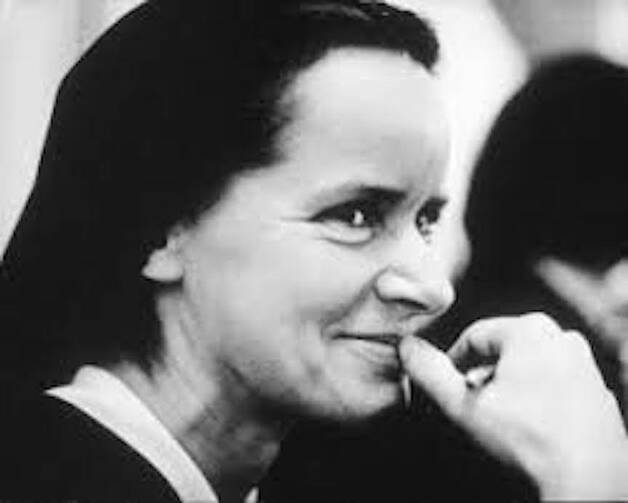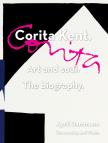Art With Heart
If you were a progressive Catholic during the tumultuous 1960s and ’70s, Sister Corita Kent’s art probably brightened your home. Her silk-screened posters and book illustrations pulsed with layers of vivid color. In breezy script, they shared quotes from her favorite thinkers—Daniel Berrigan, Thomas Merton, Dorothy Day, Ugo Betti and others—perhaps making them your favorite thinkers as well.
In 1985, as Kent neared death from cancer, the U.S. Postal Service published her “Love” stamp, sporting six colorful swashes (and a first-class postage rate of just 22 cents). More than 700 million of the stamps were sold, scattering tiny works of modern art across the nation.
Corita Kent (1918–86) deserves recognition alongside her far more famous secular counterpart, the pop artist Andy Warhol. But remarkably, no one has published a comprehensive biography of the artist who was seen by some as the “rebel nun.”
The California arts author April Dammann works to rectify that omission with Corita Kent. Art and Soul. The Biography. It stands out for its lush, high-quality reproduction of Kent’s art through the decades. The illustrations alone give reason to spend time with the volume and to mourn Kent’s untimely death at age 67.
However, Kent’s passion for artistic experimentation seems to inspire her biographer’s text. Kent might have applauded this approach, but it will frustrate the reader who seeks dates, attribution and order.
The story unfolds mostly in the present tense, with abrupt changes of scene and occasional backtracking. Type styles abound. Margins burst with quotations and scraps of research. Key details like the date of Kent’s death, are missing or difficult to find.
Most discomfiting is Dammann’s determination to tell the story from the nun’s point of view, without explaining how the author intuits Kent’s musings. For instance: “Thoughts of a walk on the beach early that morning calm and comfort her. She tries to remember details of amusing tales told by Father Berrigan at the midday meal. Hours later she is still smiling. Dan.”
This is risky business even when an author interviews a living subject. But since Kent has been dead for nearly three decades, Dammann must rely on the artist’s former pupils, friends and colleagues.
As Dammann explains in the introduction, “I felt, throughout the writing process, that Corita’s spirit blessed my efforts to judiciously project her thoughts, my analysis supported by the truths and secrets about her emotional life that trusted sources shared with me.”
The girl who would be Sister Corita, Frances Kent, was the fifth of six children in an Irish-American Catholic family. Born in Fort Dodge, Iowa, she grew up in Hollywood, Calif. After a dozen years under the tutelage of nuns, Frances entered the Immaculate Heart of Mary community as a postulant in 1936. She chose the name Sister Mary Corita, “Little Heart.”
Like many nuns of that era, Kent taught in crowded classrooms before completing her bachelor’s degree. Her artistic talent opened doors for workshops, a faculty position at Immaculate Heart College and eventually a master’s degree from the University of Southern California.
During the 1950s, her reputation grew as a gifted but demanding art teacher. She also developed in her chosen specialty, silk-screen and serigraph printmaking. Studio time took a back seat to teaching and prayer, but as early as 1952 she earned “best in show” for printmaking at the Los Angeles County Museum of Art.
During the 1960s, Kent’s fame spread. Many of her colorful prints hijacked Madison Avenue themes to convey a spiritual message. In Kent’s hands, General Mills’s slogan “The big G stands for goodness” suggested God. She riffed on the Wonder Bread wrapper, with its iconic dots of red, yellow and blue, so as to recall the ultimate wonder bread, the Communion host.
She was commissioned to create a 40-foot mural for the Vatican Pavilion at the 1964-65 New York World’s Fair. Newsweek photographed her in full habit and in secular clothes for a 1967 cover story, “The Nun: Going Modern.” And as the country grew preoccupied with war, racism, poverty and social justice, Kent’s prints followed suit.
One of the book’s recurring themes is that Kent accomplished this and more despite a decades-long battle with insomnia and depression. The author depicts Kent taking on commissions, travel and speeches atop an already heavy load of teaching and art production. Tensions between religious authorities and her reform-minded order exhausted the artist-nun. She fled to Cape Cod for a sabbatical, then abruptly left religious life in 1968.
The artist crafted a productive new life as Corita Kent, a single 50-year-old in Boston. She picked up corporate commissions, including a 150-foot rainbow to embellish a gas tank in Massachusetts. She donated time and talent to humanitarian efforts and collaborated on book and postcard projects. The author seems less interested in her subject’s life after she left her order, and the book’s final chapters feel rushed.
Dammann provides a five-page list of her sources, including histories of the era, articles about Kent and interviews with people who knew her. However, the biographer does not link these to her text by footnotes or less formal means. That leaves the reader wondering how much trust to put in any given story.
For instance, the author describes Kent’s intense friendships with three priests: the Jesuit poet Daniel Berrigan, the Sulpician spiritual director Robert J. Giguere, and (as a newly single woman in Boston) the Rev. (later Archbishop) Humberto Sousa Medeiros. Did Kent act on the passionate language of her letters to Berrigan and Giguere? Dammann doesn’t think so. The astounding story about Kent and the bishop appears to come from one of Kent’s confidantes. How much is fact, and how much fantasy? The reader cannot judge.
Despite these shortcomings, this book is a deserving tribute. (Dammann notes that the book is not endorsed by Kent’s heirs or her former religious community, but it comes across as a tribute nonetheless.)
Kent broke new artistic ground during an era when opportunities were limited for women, let alone for women religious. This book should inspire a new generation to learn more about her.
This article also appeared in print, under the headline “Art With Heart,” in the October 26, 2015, issue.











